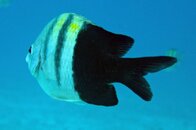my husband took this photo while shore diving right in front of Scuba Club Cozumel last week. We both saw it - the weirdest thing ever! There was a whole school of sergeant majors around the fish house, including some blue ones, which I understand to be males guarding eggs. But this one poor fish - I swear it is not photoshopped!! Has anyone ever see one like this before? Could it be some variation, or mutant?
There was a whole school of sergeant majors around the fish house, including some blue ones, which I understand to be males guarding eggs. But this one poor fish - I swear it is not photoshopped!! Has anyone ever see one like this before? Could it be some variation, or mutant?
You are using an out of date browser. It may not display this or other websites correctly.
You should upgrade or use an alternative browser.
You should upgrade or use an alternative browser.
sergeant major
- Thread starter Winterpeg
- Start date
Please register or login
Welcome to ScubaBoard, the world's largest scuba diving community. Registration is not required to read the forums, but we encourage you to join. Joining has its benefits and enables you to participate in the discussions.
Benefits of registering include
- Ability to post and comment on topics and discussions.
- A Free photo gallery to share your dive photos with the world.
- You can make this box go away
It's just an oddly colored Sergeant Major.
deborahdelamar
Contributor
Could be a hybrid. Hamlets hybridize all the time. There are studies in the Pacific that confirm hybridization amongst species of damselfish in nature, including the sergeant, from which viable offspring were produced. If it happens in one ocean, I think why not in all?
drdiver1952
Contributor
More likely its a male sargeant major going into its courtship colors which are dark blue to purple. But anything is possible.
designbysue
Contributor
Wonder if other fish point at him and laugh ;-)
Sue
Sue
SeeWorld
Registered
Because the area of dark coloration is so complete and so defined,my amateur guess is that this individual is showing melanism. I have seen it in birds but not in fish.
smellzlikefish
Contributor
Most fish-sergent majors included-can change their colors in response to mood, environment, etc. This is why some fish have different "night" colors than day, and some exhibit breeding colors when mating. Other temporary color changes include those produced by flounder to blend in and the sickly look of many aquarium specimens. This would be my guess. Some fish, I'm thinking of Ulua (Caranx spp.) will turn black when they are the dominant fish in the group. Longnosed butterflyfish (Forcipiger longirostris) are known to turn black especially on the Kona Coast, but again this is only a temporary change. In captivity, a melanistic butterfly goes back to normal color within weeks.
Hybrids are usually the product of two closely related species. Two species of sergent majors here in Hawaii are known to hybridize (Abudefduf vaigiensis and A. abdominalis) but they produce young that look an awful lot like, well, sergent majors. If the two animals are too distantly related (a hamlet and a sergent), the genes don't match up correctly and the eggs are infertile.
I'd guess if you went back, you'd find a bunch of normal fish, but I'd be interested to hear about it either way if you get the chance.
Hybrids are usually the product of two closely related species. Two species of sergent majors here in Hawaii are known to hybridize (Abudefduf vaigiensis and A. abdominalis) but they produce young that look an awful lot like, well, sergent majors. If the two animals are too distantly related (a hamlet and a sergent), the genes don't match up correctly and the eggs are infertile.
I'd guess if you went back, you'd find a bunch of normal fish, but I'd be interested to hear about it either way if you get the chance.
trigfunctions
Contributor
Great picture!
Similar threads
- Replies
- 2
- Views
- 389
- Replies
- 13
- Views
- 2,050
- Replies
- 10
- Views
- 1,478




